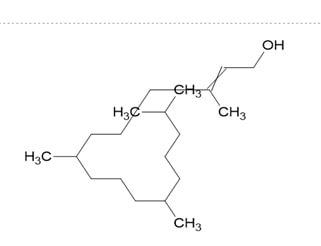Exploring the Antioxidant Activity of Phytol from the Scoparia dulcis Through In-silico Analysis

Abstract:
Diabetes is a long-term
physiological disorder that affects people of all ages and has a major negative
impact on people's ability to live normal, harmonious lives across the globe.
The discovery of innovative antidiabetic medications is necessary due to
the emergence of resistance and adverse effects of existing oral antidiabetic
drugs, even with the availability of insulin preparations and various synthetic
alternatives. Due to the side effects, Scientists are focusing on Phytotherapy.
This computational study aimed to elucidate the antioxidant activity of Phytol
by utilizing molecular docking. The objective of the current research is to
predict the Lipinski rule of 5 for Phytol. To examine the ADMET properties of
Phytol. To analyse the protein-ligand interaction of Phytol with ROS proteins
like Superoxide dismutase (PDB ID:1SPD_A), Catalase (PDB ID:1QQW_A),
Glutathione peroxidase (PDB ID:2HE3_A), Peroxiredoxin (PDB ID:1OC3_A). The
results of the in-silico studies infer that Phytol follows the Lipinski rule of
5, having a higher binding affinity with catalase protein and better hydrogen
bond interactions with Superoxide dismutase and Glutathione peroxidase. The
current study provides evidence that Phytol reduces oxidative stress. However,
additional in-vitro and in-vivo research are needed to understand the
prediction process.
References:
[1].
GBD, 2021, Diabetes Collaborators,
2023, Global, regional, and national burden of diabetes from 1990 to 2021, with
projections of prevalence to 2050: a systematic analysis for the Global Burden
of Disease Study 2021. Lancet (London, England), 402(10397), 203–234. https://doi.org/10.1016/S0140-6736(23)01301-6.
[2].
Jayaraman, S., Natarajan, S. R.,
Ponnusamy, B., Veeraraghavan, V. P., & Jasmine, S., 2023, Unlocking the
potential of beta sitosterol: Augmenting the suppression of oral cancer cells
through extrinsic and intrinsic signalling mechanisms. The Saudi Dental
Journal, 35(8), 1007-1013.
[3].
Kharroubi, A. T., & Darwish, H.
M., 2015, Diabetes mellitus: The epidemic of the century. World Journal of Diabetes,6(6),850–867.
https://doi.org/10.4239/wjd.v6.i6.850.
[4].
Baynes, J. W., & Thorpe, S. R.,
1999, Role of oxidative stress in diabetic complications: A new perspective on
an old paradigm. Diabetes, 48(1), 1–9. https://doi.org/10.2337/diabetes.48.1.1
[5].
Sruthi, M. A., Mani, G., Ramakrishnan,
M., & Selvaraj, J., 2023, Dental caries as a source of Helicobacter pylori
infection in children: An RT‐PCR study. International Journal of
Paediatric Dentistry, 33(1), 82-88.
[6].
Navrot, N., Rouhier, N., Gelhaye,
E., & Jacquot, J. P., 2007, Reactive oxygen species generation and
antioxidant systems in plant mitochondria. Physiologia Plantarum, 129(1),
185-195.
[7].
Mittler, R., Vanderauwera, S.,
Gollery, M., & Van Breusegem, F., 2004, Reactive oxygen gene network of
plants. Trends in Plant Science, 9(10), 490–498. https://doi.org/10.1016/j.tplants.2004.08.009.
[8].
Jayaraman, S., Natarajan, S. R.,
Veeraraghavan, V. P., & Jasmine, S., 2023, Unveiling the anti-cancer
mechanisms of calotropin: Insights into cell growth inhibition, cell cycle
arrest, and metabolic regulation in human oral squamous carcinoma cells
(HSC-3). Journal of Oral Biology and Craniofacial Research, 13(6),
704-713.
[9].
Li, G. Q., Kam, A., Wong, K. H.,
Zhou, X., Omar, E. A., Alqahtani, A., Li, K. M., Razmovski-Naumovski, V., &
Chan, K., 2012, Herbal medicines for the management of diabetes. Advances in Experimental Medicine and Biology, 771, 396–413. https://doi.org/10.1007/978-1-4614-5441-0_28.
[10]. Kazeem, M. I., & Davies, T. C., 2016, Anti-diabetic
functional foods as sources of insulin secreting, insulin sensitizing and
insulin mimetic agents. Journal of Functional
Foods, 20, 122-138.
[11]. Krishnan, R. P., Pandiar, D., Ramani, P., & Jayaraman,
S., 2025, Molecular profiling of oral epithelial dysplasia and oral squamous
cell carcinoma using next generation sequencing. Journal of
Stomatology, Oral and Maxillofacial Surgery, 126(4), 102120.
[12]. Reshma Rajan, R. R., Mahima Vedi, M. V., Badrinathan
Sridharan, B. S., Himaja, M., Sabina, E. P., & Raj, N. A. N., 2014, In
vitro and in vivo study on the effect of Scoparia dulcis in inhibiting the
growth of urinary crystals. Internatinal Journal of Phytomedicine
6, 617-624.
[13]. Pazhani, J., Chanthu, K., Jayaraman, S., & Varun, B. R.,
2023, Evaluation of salivary MMP-9 in oral squamous cell carcinoma and oral
leukoplakia using ELISA. Journal of Oral and Maxillofacial Pathology, 27(4),
649-654.
[14]. Brown, P. J., Mei, G., Gibberd, F. B., Burston, D., Mayne,
P. D., McClinchy, J. E., & Sidey, M., 1993, Diet and Refsum's disease. The
determination of phytanic acid and phytol in certain foods and the application
of this knowledge to the choice of suitable convenience foods for patients with
Refsum's disease. Journal of Human Nutrition and Dietetics, 6(4),
295-305.
[15]. Islam, M. T., Ali, E. S., Uddin, S. J., Shaw, S., Islam, M.
A., Ahmed, M. I., Chandra Shill, M., Karmakar, U. K., Yarla, N. S., Khan, I.
N., Billah, M. M., Pieczynska, M. D., Zengin, G., Malainer, C., Nicoletti, F.,
Gulei, D., Berindan-Neagoe, I., Apostolov, A., Banach, M., Yeung, A. W.
K.,Atanasov, A. G., 2018, Phytol: A review of biomedical activities. Food
and chemical toxicology: An International Journal Published for the British
Industrial Biological Research Association, 121, 82–94. https://doi.org/10.1016/j.fct.2018.08.032.
[16]. Fathima, J. S., Jayaraman, S., Sekar, R., & Syed, N. H.,
2024, The role of MicroRNAs in the diagnosis and treatment of oral premalignant
disorders. Odontology, 1-10.
[17]. Eliza, J., Daisy, P., & Ignacimuthu, S., 2010,
Antioxidant activity of costunolide and eremanthin isolated from Costus speciosus (Koen ex. Retz) Sm. Chemico-Biological
Interactions, 188(3), 467–472. https://doi.org/10.1016/j.cbi.2010.08.002.
[18]. Brooijmans, N., & Kuntz, I. D., 2003, Molecular
recognition and docking algorithms. Annual Review of Biophysics and
Biomolecular Structure, 32, 335–373. https://doi.org/10.1146/annurev.biophys.32.110601.142532.
[19]. Kitchen, D. B., Decornez, H., Furr, J. R., & Bajorath,
J., 2004, Docking and scoring in virtual screening for drug discovery: methods
and applications. Nature reviews. Drug Discovery, 3(11),
935–949. https://doi.org/10.1038/nrd1549.
[20]. Pari, L., & Latha, M., 2004, Protective role of Scoparia
dulcis plant extract on brain antioxidant status and lipidperoxidation in STZ
diabetic male Wistar rats. BMC Complementary and Alternative Medicine,
4, 16. https://doi.org/10.1186/1472-6882-4-16.
[21]. Lin, H. D., Lee, Y. C., Chiang, C. Y., Lin, Y. J., Shih, C.
Y., Tsai, R. K., Lin, P. Y., Lin, S. Z., Ho, T. J., & Huang, C. Y., 2023,
Protective effects of Scoparia dulcis L. extract on high glucose-induced injury
in human retinal pigment epithelial cells. Frontiers in Nutrition, 10,
1085248. https://doi.org/10.3389/fnut.2023.1085248.
[22]. Sivasankarapillai, V. S., Krishnamoorthy, N., Eldesoky, G.
E., Wabaidur, S. M., Islam, M. A., Dhanusuraman, R., & Ponnusamy, V. K.,
2022, One-pot green synthesis of ZnO nanoparticles using Scoparia dulcis plant
extract for antimicrobial and antioxidant activities. Applied Nanoscience, 1–11.Advance online publication. https://doi.org/10.1007/s13204-022-02610-7.
[23]. Mishra, M. R., Mishra, A., Pradhan, D. K., Panda, A. K.,
Behera, R. K., & Jha, S., 2013, Antidiabetic and Antioxidant Activity of Scoparia dulcis Linn. Indian Journal of Pharmaceutical Sciences, 75(5), 610–614.
[24]. Moniruzzaman, M., Atikur Rahman, M., & Ferdous, A.,
2015, Evaluation of Sedative and Hypnotic Activity of Ethanolic Extract of Scoparia dulcis Linn. Evidence-based
complementary and alternative medicine: eCAM, 2015, 873954. https://doi.org/10.1155/2015/873954.
[25]. Benarfa, A., Gourine, N., Mahfoudi, R., Harrat, M., &
Yousfi, M., 2019, Effect of Seasonal and Regional Variations on Phenolic
Compounds of Deverra scoparia
(Flowers/Seeds) Methanolic Extract and the Evaluation of Its in Vitro
Antioxidant Activity. Chemistry & Biodiversity, 16(11), e1900420. https://doi.org/10.1002/cbdv.201900420.
[26]. Coulibaly, A. Y., Kiendrebeogo, M., Kehoe, P. G., Sombie, P.
A., Lamien, C. E., Millogo, J. F., & Nacoulma, O. G., 2011, Antioxidant and
anti-inflammatory effects of Scoparia
dulcis L. Journal of Medicinal
Food, 14(12), 1576–1582. https://doi.org/10.1089/jmf.2010.0191.
[27]. Yasothkumar, D., Ramani, P., Jayaraman, S., Ramalingam, K.,
& Tilakaratne, W. M., 2024, Expression Profile of Circulating Exosomal
microRNAs in Leukoplakia, Oral Submucous Fibrosis, and Combined Lesions of
Leukoplakia and Oral Submucous Fibrosis. Head and Neck Pathology, 18(1),
28.
[28]. Sagar, S., Ramani, P., Moses, S., Gheena, S., & Selvaraj, J., 2024, Correlation of salivary cytokine IL-17A and 1, 25 dihydroxycholecalciferol in patients undergoing orthodontic treatment. Odontology, 1-10.

